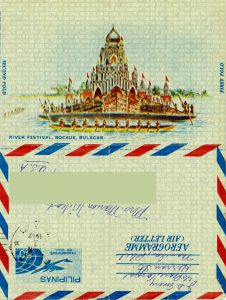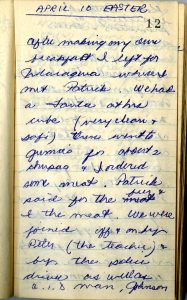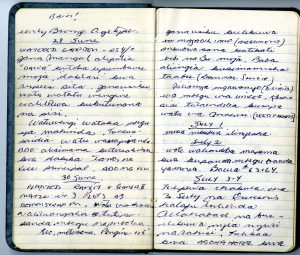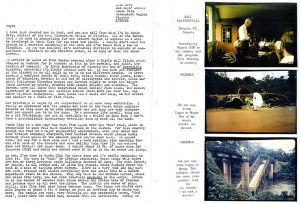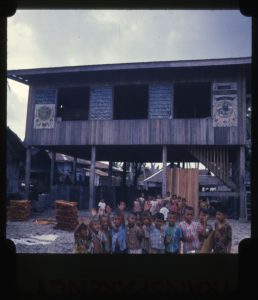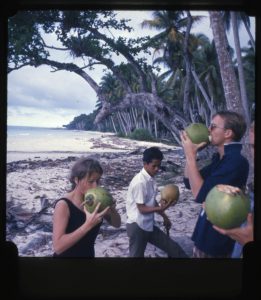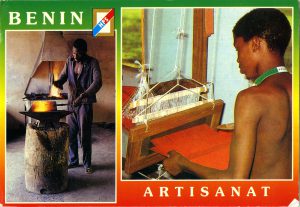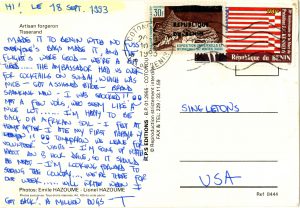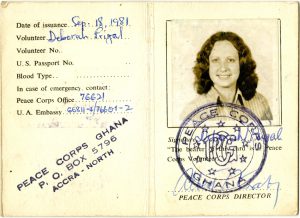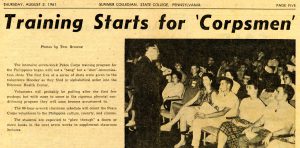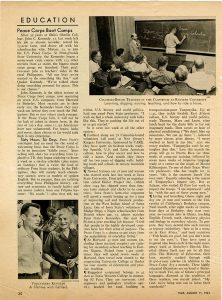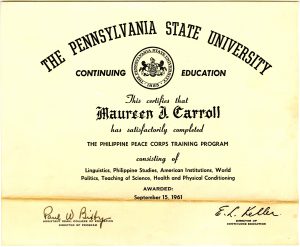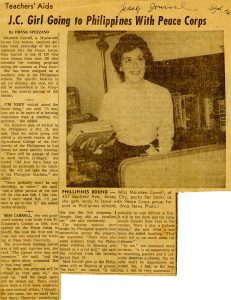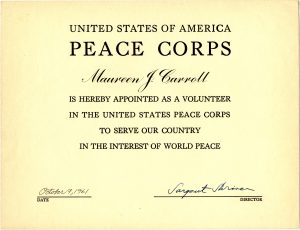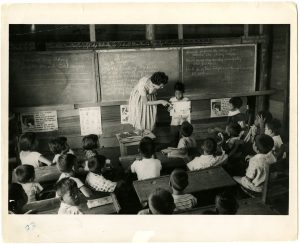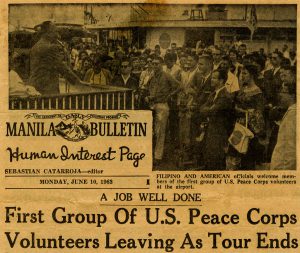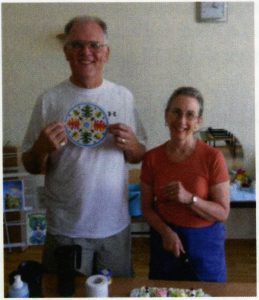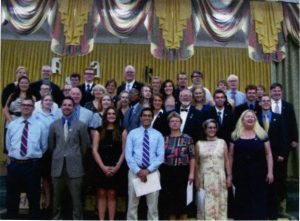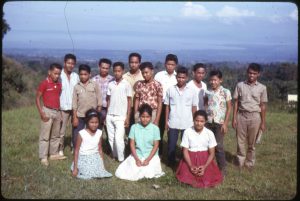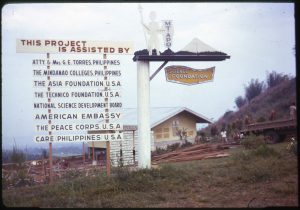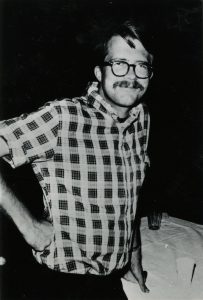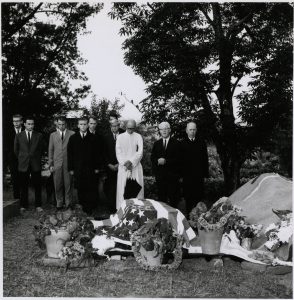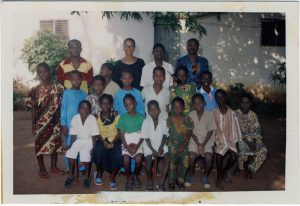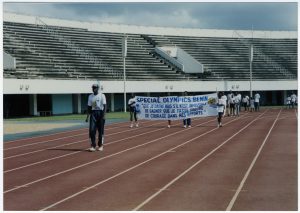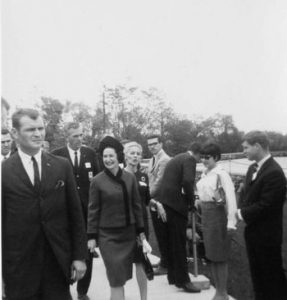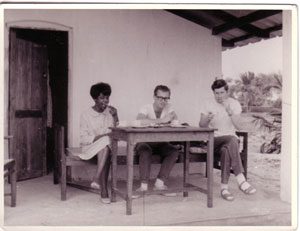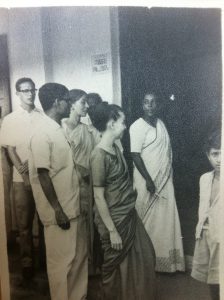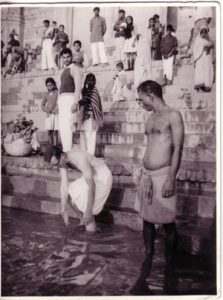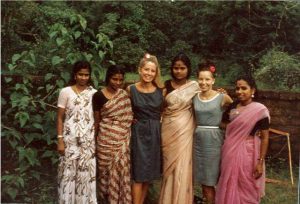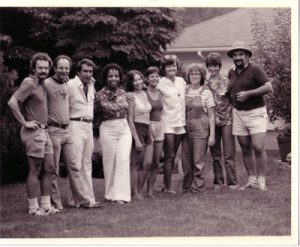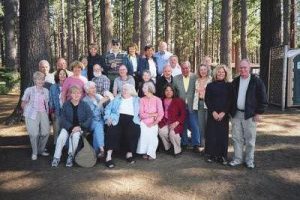Country of Service: Uganda, Kenya, Tanzania
Service Type: Secondary Education, Librarian
Dates in Service: 1970-1972, 1973-1976, 1980-1982
Keywords: Education, Libraries
Accession Date: March 9, 2018
Access: No restrictions.
Collection Size: 4.0 linear feet
Document Types
Uganda
Photographs
Correspondence
Sound
Official Paperwork
Training Materials
Assignment
Articles
Travel brochures, maps, postcards
Kenya
Photographs
Correspondence
Official Paperwork
Assignment
Travel brochures, postcards
Tanzania
Photographs
Correspondence
Official Paperwork
Assignment
Travel postcards
Finding Aid
Box 1
Uganda
-
- Application Materials
- Application # card
- Application rcvd. Notification
- Peace Corps booklet
- Draft of volunteer application
- Brochures & Postcards
- Tourist brochures
- postcards
- Cassette of Gail speaking to parents
- One cassette tape of Gail speaking to her parents, C. Morton and A. Jean Wadsworth.
- The tape contains Gail’s first impressions of Uganda and about Peace Corps training June-Sept, 1970 in Kampala, Tororo, Lake Victoria. It also includes descriptions of photos on two rolls of film Gail took during this time and sent to her parents to be processes. Listing of photos included.
- Correspondence, 1969-1971 (1/2)
- (These letters written by Gail to her parents, C. Morton and A. Jean Wadsworth.)
- 3 letters: December 8, 1969 to January 1970 referring to Peace Corps availability date and application.
- 104 letters: June 1970-Sept 1972
- Correspondence, 1971-1972 (2/2)
- Newspaper Articles
- Various articles about Uganda during this time period.
- Official Paperwork
-
- Peace Corps ID card
- Passport
-
- Photographs
- 49 photos taken during peace corps service in Uganda (many of the photos are prints of the slides included in the donation)
- Post Evacuation Materials
- Peace Corps Volunteers were evacuated from Uganda in Sept & Oct 1972. These items are post evacuation materials. Includes Description of Service.
- School Stuff
- Gail was a PCV English as a Second Language teacher at Tororo Girls’ School in Tororo, Uganda. She was also Adviser for the student publications “The Voice” (one copy included) and the literary magazine “Beyond These Gates” (2 copies included) and the students for two years – first in Form 2 (sophomores) and then in Form 3 (juniors). Class list included along with the East African certificate Exam results.
- Three articles related to Tororo Girls’ School:
- US 1A World Sept. 1986: Article with pictures of Gail and former Tororo Girls’ School student Annie Kakooza. Annie followed in Gail’s footsteps and became a qualified librarian.
- Article with pictures of Tororo Girls’ School and students during Gail’s time teaching there.
- Weatherford, Oklahoma article about former Peace Corps Volunteers Lucille and Henry Simmons who taught at Tororo Girls’ School with Gail in 1970.
- Application Materials
11. Slides
- Photos and descriptions
- Box of 91 Extrachrome slides
- CD-Rom of digitized versions of the slides
- Printout of descriptions of the individual slides
12.Training
-
-
-
-
-
- Invitation to train, staging in Philadelphia, various items
- Uganda Argus newspaper – May 22, 1972 – Article with photos of P.C. Training group on arrival in Uganda. Gail appears in two of the photos.
- Training Materials/Newsletter
- Items provided by P.C./Uganda to trainees during training in Uganda 1970. 10th Anniversary Volunteer newsletter distributed to Volunteers 1971.
- Uganda Tourist Brochure Map
- Uganda tourist brochure map
-
-
-
-
Kenya
-
-
-
-
-
-
- Brochures, Stamps, and Postcards
- Tourist brochures and stamps and postcards
- Correspondence, 1973 Kenya A (1/2)
- 261 letters written by Gail to her parents, C. Morton and A. Jean Wadsworth 1973-1976. Kenya A, 150 letters.
- Correspondence, 1974 Kenya A (2/2)
- Correspondence, 1975-1976 Kenya B
- Kenya B, 111 letters.
- Kenya Volunteers Documents
- Miscellaneous documents related to Peace Corps Kenya Volunteers and staff and specifically to Gail’s assignment as a librarian with the Kenya National Library services. Includes description of service.
- Library Services
- Miscellaneous documents regarding Kenya National Library Services, where Gail was posted as a Volunteer librarian, and Kenya Librarian Association and other libraries in Kenya.
- Miscellaneous Documents
- Official
- Passport
- Peace Corps Kenya ID Cards (2)
- Kenya Drivers License
- International Driving Permit
- Photographs
- 60 photos
- Slides and Photos
- 70 Extrachrome Photographic Slides
- CD-Rom of digital versions of the slides plus description document
- Printed descriptions of the slides
- Brochures, Stamps, and Postcards
-
-
-
-
-
4. Tanzania
- Correspondence, May-October, 1980
- 129 letters from Gail to her parents, C. Morton and A. Jean Wadsworth, 1980-82. Applying for and preparing for Tanzania PCV/UNV contract. 5 letters.
- Correspondence, November 1980-April 1981 (1/2)
- 129 letters from Gail to her parents, C. Morton and A. Jean Wadsworth, 1980-1982. Tanzania, 11/1980 – 12/1981. 69 letters.
- Correspondence, May-December, 1981 (2/2)
Box 2
- Correspondence, January-June, 1982 (1/2)
- 129 letters from Gail to her parents, C. Morton and A. Jean Wadsworth, 1980-1982. Tanzania, 1/1982 – 11/1982.
- Correspondence, July-December, 1982 (2/2)
- Photographs
- 39 photos
- Postcards and Stamps
- Official Documents
- Miscellaneous documents
- WHO International Certificate of Vaccination – yellow booklet
- Passport
- East African Management Institute ID Card
- Tanzania Driving License (2 – class A – Class D)
- Documents and Brochures, Arusha
- Documents and brochures related to the Easterman Southern African Management Institute, Arusha where Gail was assigned as a PCV/UNV librarian.
- Slides & CD
- 113 Extrachrome Photographic slides
- Printout of descriptions of slides
- CD-Rom digital versions of slide photos
- Miscellaneous Documents, PC & UN (1/2)
- Miscellaneous documents related to Peace Corps/United Nations Volunteer assignment. Includes description of service. (Chronological order).
- Miscellaneous Documents, PC & UN (2/2)

